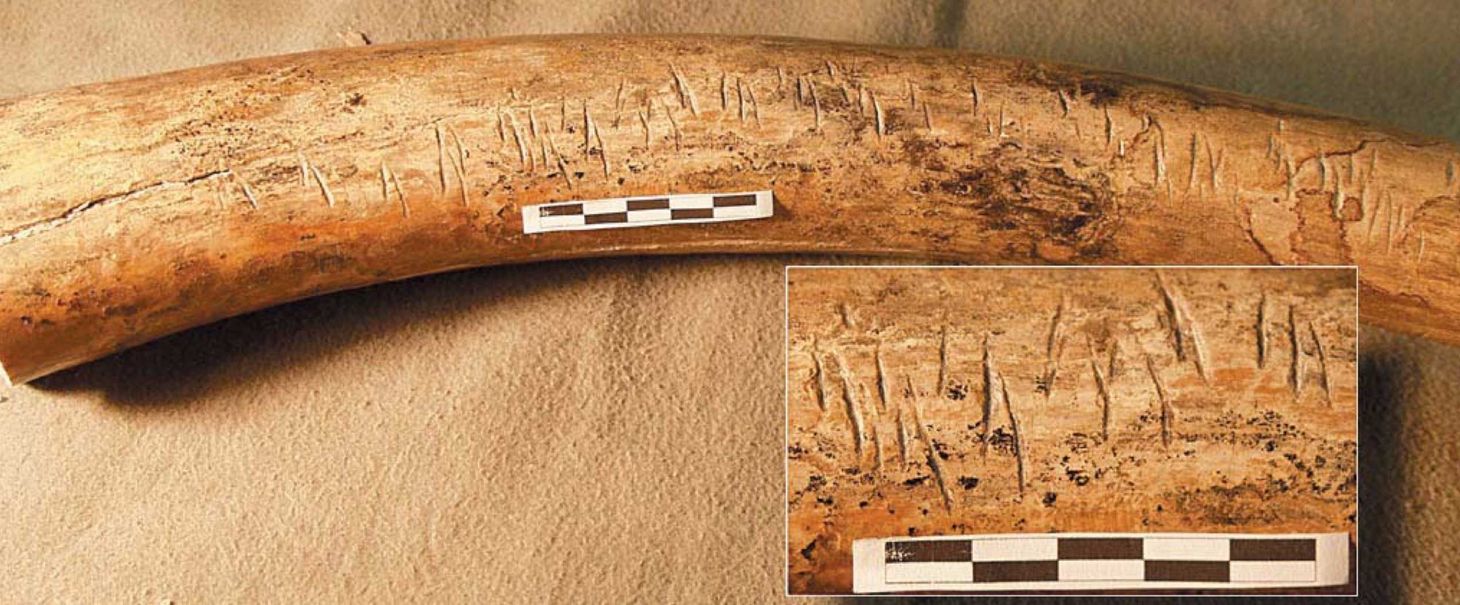Who first inhabited the European Arctic? A look at Mamontovaya Kurya
I examine a new paper reviewing a site in the far north of European Russia, with critical examination of the idea that Neandertals were this far north 40,000 years ago.

Note: I wrote this post in 2005 as I reviewed recent work on the archaeology of Mamontovaya Kurya. The identity of people who were responsible for this and other Arctic sites remains unclear. What has changed over the last 20 years is the chronology of late Neandertals and early modern people in eastern and central Europe more broadly. Today most archaeologists would probably argue that a 40,000-year-old assemblage likely was not made by Neandertals, agreeing with the points I make in this post. Later posts on the site discuss these aspects of European prehistory with more recent datasets.
I happened across an article by Pavlov and colleagues (2001) about the Mamontovaya Kurya site in the Russian Arctic. From the abstract:
The transition from the Middle to the Upper Palaeolithic, approximately 40,000-35,000 radiocarbon years ago, marks a turning point in the history of human evolution in Europe. Many changes in the archaeological and fossil record at this time have been associated with the appearance of anatomically modern humans. Before this transition, the Neanderthals roamed the continent, but their remains have not been found in the northernmost part of Eurasia. It is generally believed that this vast region was not colonized by humans until the final stage of the last Ice Age some 13,000-14,000 years ago. Here we report the discovery of traces of human occupation nearly 40,000 years old at Mamontovaya Kurya, a Palaeolithic site situated in the European part of the Russian Arctic. At this site we have uncovered stone artefacts, animal bones and a mammoth tusk with human-made marks from strata covered by thick Quaternary deposits. This is the oldest documented evidence for human presence at this high latitude; it implies that either the Neanderthals expanded much further north than previously thought or that modern humans were present in the Arctic only a few thousand years after their first appearance in Europe.
An interesting start, that. The archaeology includes a mammoth tusk with marks that may be the result either of deliberate incision or of chopping of other material using the tusk as an anvil. The radiocarbon date of bones and the tusk range between 34,400 and 37,400 years ago.
There are no fossil humans at this site. The authors raise the issue of attribution, noting that the date of the site would mean that modern humans had expanded into the Arctic fringe very shortly after they appeared in Europe.
A pressing question is whether the pioneers who lived in these northern landscapes were members of the ancient Neanderthal population (Homo sapiens neanderthalensis) or newcomers from the south. Most scholars associate the Aurignacian industry—the more advanced stone-tool technology that appeared in Europe at around 40,000 yr BP—with the emergence of modern humans. However, the earliest indisputable remains of humans with a fully modern morphology (Homo sapiens sapiens) date to 30,000-35,000 yr BP; that is, well after the archaeologically defined transition from the Middle to the Upper Palaeolithic. In European Russia, well preserved skeletons from the famous Palaeolithic site of Sungir, northeast of Moscow (Fig. 1), show that anatomically modern humans were present there not later than 28,000 yr BP. At the Kostenki IV site on the west bank of the Don river, bones of modern humans have been uncovered from strata dated to 30,000 yr BP. The stone-working technology reflected in the Byzovaya material is similar to that of Sungir and other early Upper Palaeolithic sites of the eastern Szeletien tradition, indicating that these artefacts were manufactured by modern humans. However, whether the person who inflicted the marks on the tusk from Mamontovaya Kurya, as much as 8,000-9,000 years earlier, belonged to the same human lineage as the residents at Byzovaya and other Palaeolithic sites further to the south is more uncertain.
They also relate the site extensively to the Byzovaya site in the preceding paragraph, noting the archaeology has been classified as “eastern Szeletien with Aurignacian traits”.
I remembered Szeletian as a Neandertal-associated “transitional” Upper Paleolithic industry, so I went on a bit of a search to see what the story actually is. The search is not finished yet, as there are some books to consult, but the short answer is that Szeletian means different things to different archaeologists. From Churchill and Smith (2000:75, citations in original):
Most of the various IUP [Initial Upper Paleolithic] cultures of Central and Eastern Europe that are characterized by leaf points have at one time or another been seen as regional variants of the Szeletian, a culture defined at Szeleta Cave in the Bukk Mountains of Hungary (Allsworth-Jones 1990a). Regional distinctions can be identified, however, and the possibility exists as well that the occurrence of leaf points in different regions may be the result, at least in some cases, of convergence (Allsworth-Jones 1990a). Regionally defined leaf-point cultures include the Brynzeny, the Gordineshty, and the Kostenki-Streletsian (Streletskaya) of the Russian Plain (Anikovich 1992), the Altmuhlian of southern Germany, the Jerzmanowician of eastern Germany and Poland, the Bohunician of the Czech Republic (in which leaf points are relatively rare, leading to suggestions that this industry should be considered as a development separate from the Szeletian: Svoboda 1998, 1990), and the Jankovichian (although this might be seen as a Middle Paleolithic industry with leaf points: Gabori-Csank 1990) and the Szeletian sensu stricto of Hungary (see Allsworth-Jones 1990a).
Whoa. At a glance, it sounds like like the Szeletian is defined by leaf points in about the same way that the Aurignacian is defined by split-base bone points, and is therefore just about as unitary. In other words, it barely hangs together. Like I said, I'm working on understanding this better, but my predilection is to step away from the names and consider the possibility that the “Szeletian” really is a constellation of behaviors weakly if at all linked, and it therefore has no necessary link to biological differences between human populations.
The argument for the Szeletian being the product of the Neandertals is almost entirely based on the similarities between it and the earlier Micoquian industry. There are only two sites with human remains associated with Szeletian assemblages, and neither of these has been clearly shown to be Neandertal in anatomy (the sum total is four teeth from both sites) (Churchill and Smith 2000). The case for archaeological similarity, and the status of the Szeletian as a "transitional" industry, is presented by Valoch (2000):
The situation with the Szeletian is quite different. Even though it is also likely to have been produced by the Neanderthals, the stone industry differes from the Bohunician in completely lacking a Levalloisian component. Typological and technological analyses have shown that the archaic elements of the industry are Micoquian and reflect a technological complex that was widespread in Central Europe. However, the types characteristic of the Upper Palaeolithic are carinated and nosed scrapers and carinated burins -- shapes exclusive to the Aurignacian (Allsworth-Jones 1986, 1990; Oliva 1991, 1992; Valoch et al. 1993). The only type specific to the Szeletian -- the leaf point -- has its origin in the Micoquian. The genesis of such an industry can be explained in only two ways: either it developed as a result of spontaneous substrate evolution (i.e., Micoquian), in which case the different Aurignacian types developed in parallel or almost simultaneously and quite independently of the Aurignacian proper, or the Aurignacian had a share in the formation of the industry through some form of contact with the Micoquian. No other explanation appears viable today, although future studies may produce new information (Valoch 2000:625).
The argument for the eastern Szeletian being the product of modern humans apparently comes from the association with the remains at Sungir. Since these are not necessarily the same cultural tradition as other Szeletian sites (despite the shared name), there seems not to be a conflict.
The implication that the far northern tier of Eurasia was occupied very early by modern humans is another piece of evidence consistent with the idea that the first modern Europeans came from the far north. This hypothesis proposes that the features that people spread into the Palearctic as a rather specialized adaptation, and may have exploited a niche available to highly mobile, long-limbed, and culturally sophisticated people. Ultimately, the eastern extreme of this population may have moved into Beringia and further to the New World.
A list of online resources related to the topic of Paleolithic occupation of the circumarctic is maintained at WorkingDogWeb, which I assume is related because of dogsleds?
References:
Churchill, S. E., & Smith, F. H. (2000). Makers of the early Aurignacian of Europe. American Journal of Physical Anthropology, 113(S31), 61-115.
Pavlov, P., Svendsen, J. I., & Indrelid, S. (2001). Human presence in the European Arctic nearly 40,000 years ago. Nature, 413(6851), 64-67.
Valoch, K. (2000). More on the question of Neanderthal acculturation in Central Europe. Current Anthropology, 41(4), 625-626.
John Hawks Newsletter
Join the newsletter to receive the latest updates in your inbox.



